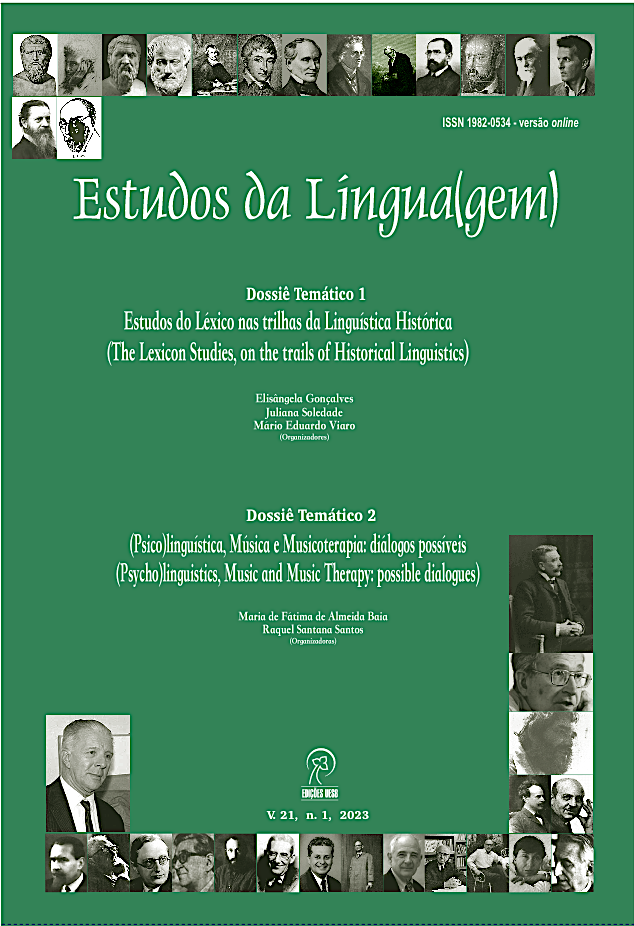Unraveling threads of children's speech and singing: different shades of the same color
DOI:
https://doi.org/10.22481/el.v21i1.13373Keywords:
Singing acquisition; Speech; Vocal development; Acoustic analysis; Early infancy.Abstract
Speech and singing are two human communicative functions that share cognitive and neural processes and whose interrelation has always interested researchers in both areas. However, there are few studies that compare the vocalizations obtained in those two contexts, especially in babies and preschool-age children. The present investigation followed the development of the singing voice of children during the second year of life, in two different conditions – speaking and singing. The segmental properties and melodic and rhythmic features of the obtained vocalizations were acoustically analyzed. The results showed significant differences in the vocalizations to which the two stimulus conditions gave rise, namely in relation to the duration of the vocalizations and to their vocal extension. This may reveal that there is an early distinction between the singing voice and the speaking voice. Observations on the role of early musical acculturation and education are made, suggesting clues for future investigations in this area.
Downloads
References
ADACHI, M., & TREHUB, S. E. Musical lives of infants. In: MCPHERSON, G. & WELCH, G. (Eds.). The Oxford handbook of music education. New York: Oxford University Press, 2012, p. 229-247.
BERGESON, T. R., & TREHUB, S. E. Signature tunes in mothers' speech to infants. Infant Behavior and Development, 30, p. 648-654, 2007.
BERTONCINI, J., FLOCCIA, C., NAZZI, T., & MEHLER, J. Morae and syllables: Rhythmical basis of speech representations in neonates. Language and Speech, 38(4), p. 311–329, 1995.
BOERSMA, P., & WEENINK, D. Praat: Doing phonetics by computer (Version 4.4.04) [software]. Disponível em: http://www.praat.org/. Acesso em: 3 de novembro de 2021
COSTA-GIOMI, E., & ILARI, B. Infants’ preferential attention to sung and spoken stimuli. Journal of Research in Music Education, 62(2), p. 188–194, 2014.
DOWLING, W. J. The development of music perception and cognition. In: DEUTSCH, D. (Ed.), The psychology of music. San Diego: Academic Press. 1999, p. 603-625.
FOX, D.B. The pitch range and contour of infant vocalization. Peter Costanza. 1982. Dissertação de Doutoramento em Educação Musical. Ohio State University.
GORDON, E. Teoria de aprendizagem musical. Competências, conteúdos e padrões. Tradução por Maria de Fátima Albuquerque. Lisboa: Fundação Calouste Gulbenkian, 2000.
LEVINOWITZ. L., BARNES, P., GUERRINI, S., CLEMENT, M., D'APRIL, P. & MOREY, M. Measuring Singing Voice Development in the Elementary General Music Classroom. Journal of Research in Music Education. 46(1), p. 35-47, 1998.
LONGHI, E. ‘Songese’: Maternal structuring of musical interaction with infants. Psychology of Music, 37, p. 195–213, 2009.
MOOG, H. The musical experience of the pre-school child. London: Schott, 1976.
NAKATA, T., & TREHUB, S. E. Infants’ responsiveness to maternal speech and singing. Infant Behavior & Development, 27, p. 455–464, 2004.
PAPOUŠEK, M. Intuitive parenting. In: DELIÈGE, I.; SLOBODA, J. (Eds.). Musical beginnings: Origins and development of musical competence. Oxford: University Press, 1996, p. 88-112.
PATEL, A. Music, language, and the brain. New York: Oxford University Press, 2008.
REIGADO, J., ROCHA, A., & RODRIGUES, H. Vocalizations of infants (9–11 months old) in response to musical and linguistic stimuli. International Journal of Music Education, 29(3), p. 241–255, 2011.
SALSELAS, I., & HERRERA, P. Music and speech in early development: Automatic analysis and classification of prosodic features from two Portuguese variants. Journal of Portuguese Linguistics, 9(10), p. 11–36, 2011.
SCOTTO DI CARLO, N. Contraintes de production et intelligibilité de la voix chantée. Travaux Interdisciplinares du Laboratoire Parole et Langage, 24, p. 159–179, 2005.
STALINSKI, S., & SCHELLENBERG, E. G. Shifting perceptions: Developmental changes in judgments of melodic similarity. Developmental Psychology, 46(6), p. 1799–1803, 2010.
TAFURI, J., & VILLA, D. Musical elements in the vocalizations of infants aged 2–8 months. British Journal of Music Education, 19(1), p. 73–88, 2002.
TREHUB, S. E., & GUDMUNDSDOTTIR, H. R. Mothers as singing mentors for infants. In: WELCH, G.; HOWARD, D.; & NIX, J. (Eds.). The Oxford handbook of singing. Oxford: Oxford University Press, 2015, p. 455-469
TREHUB, S., & HANNON, E. Conventional rhythms enhance infants’ and adults’ perception of musical patterns. Cortex, 45, p. 110–118, 2009.
TREHUB, S. E., & THORPE, L. A. Infants’ perception of rhythm: Categorization of auditory sequences by temporal structure. Canadian Journal of Psychology, 43, p. 217–229, 1989.
Downloads
Published
How to Cite
Issue
Section
License

This work is licensed under a Creative Commons Attribution 4.0 International License.

Estudos da Língua(gem) is licensed under a Creative Commons Attribution 4.0 International License.
Authors who publish in the journal Estudos da Língua (gem) agree with the following terms:
The journal Estudos de Língua(gem) maintains the copyrights of the contributions published. These rights include the publication of the contribution and make its content available for free through the portal.







